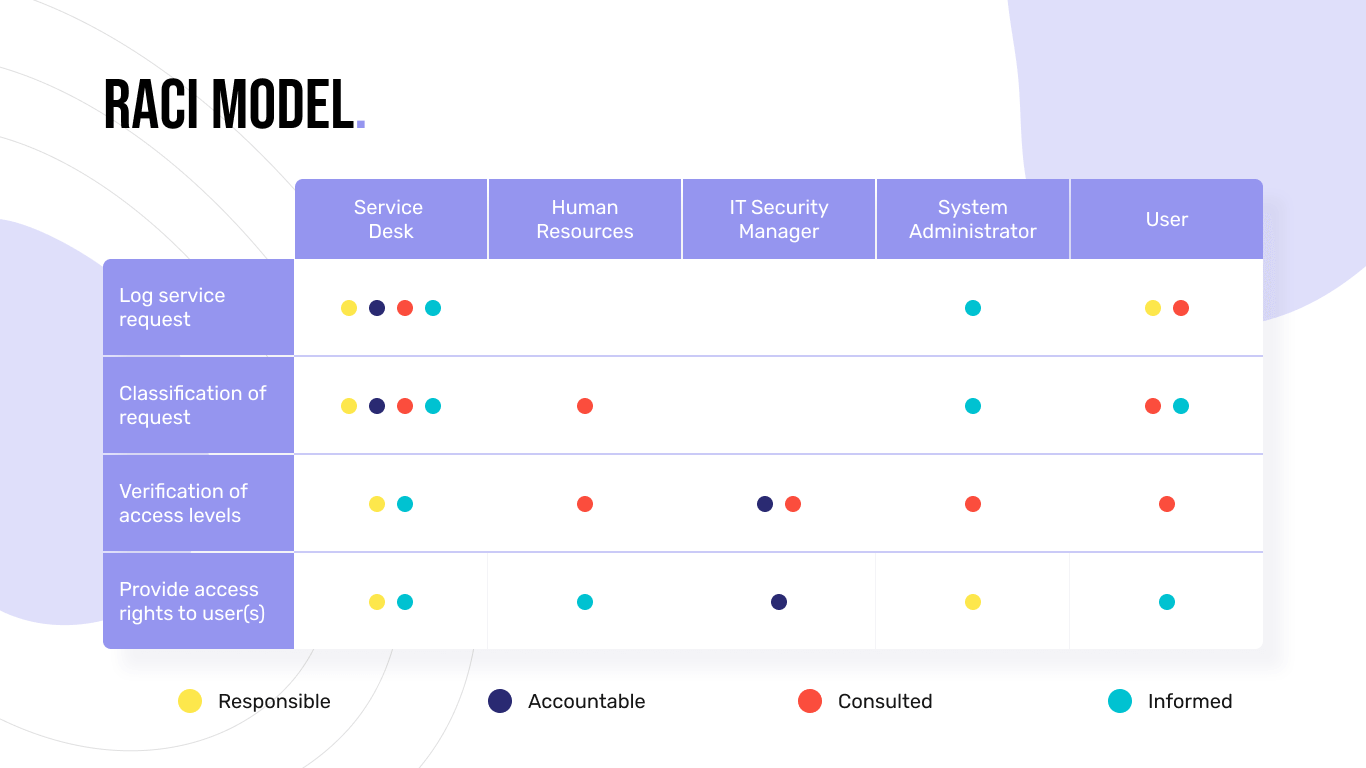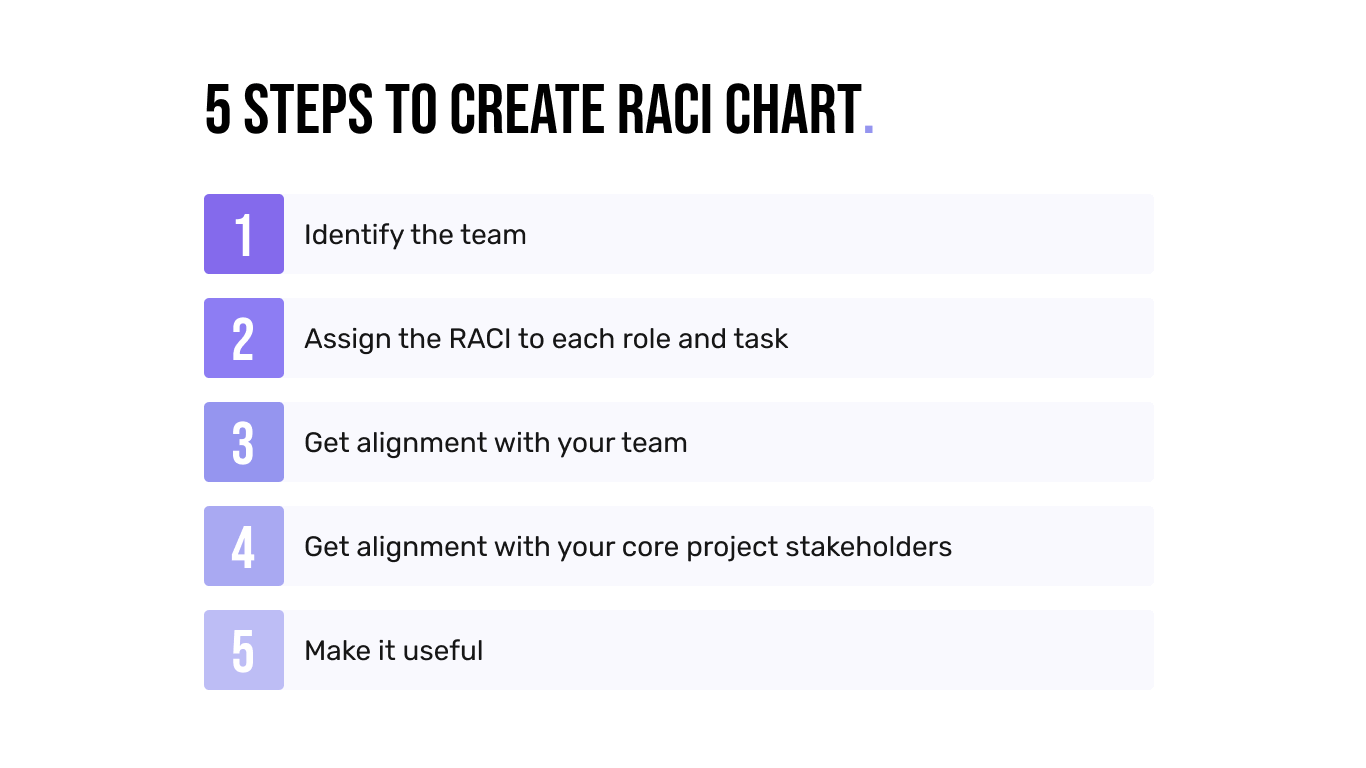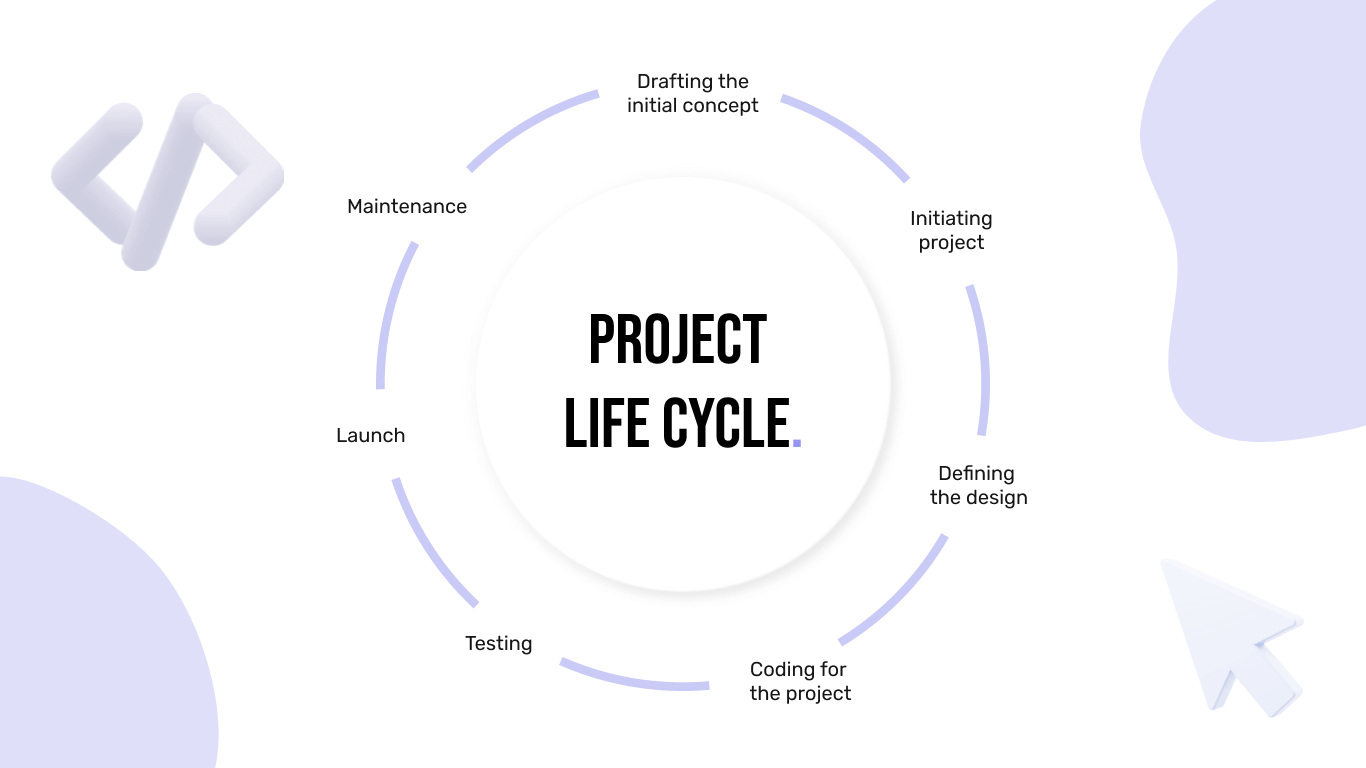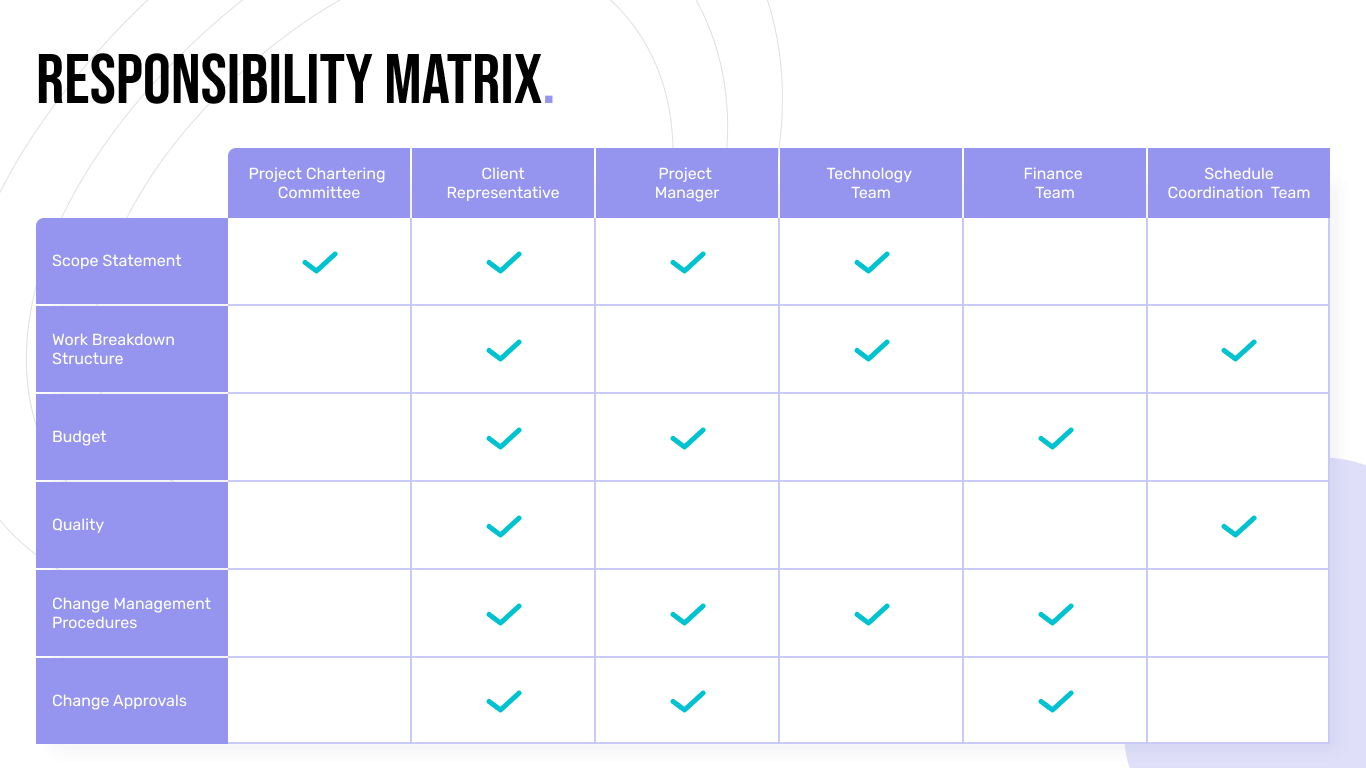If you are a project manager looking for software that will make your life easier, the RACI chart is the way to go.
Despite its incredible usability at the beginning of the project, this tool can be the elephant in the room that no one wants to complete, review, or apply whatsoever.
So how can you make RACI a helpful tool for you and your project? Let’s take a closer look!

RACI Matrix: What Is It, and Why Use It?
Numerous businesses use the RACI model for project management. Its most common application is in the information technology industry. High turnover of projects in the sector requires multiple approaches to manage them successfully. Before we show you what the RACI model is used for, let’s cover the basics of a RACI matrix.
What is a RACI matrix?
The RACI matrix is a responsibility assignment tool for defining and documenting project roles and duties. With the help of this tool, businesses can map out every task, milestone, or KPI involved in completing a project. In addition, the RACI matrix allows you to assign the roles responsible for each action item.
This tool is most beneficial for traditional teams that are not implementing Agile management. With a RACI matrix, a company will always be informed about every aspect of a project, including who is accountable, who needs to be consulted, and who must be informed at every step.
The main roles of the matrix
The RACI model for project management allows supervisors to measure progress through a matrix of individual assignments and division of responsibilities.
RACI is an acronym. Its meaning is derived from the values or roles that describe the people performing project tasks.
The main roles in the RACI matrix are:
-
Responsible – aimed at people liable for completing the task at hand. That means every project has at least one person doing the work. In general, this person can delegate and lead the completion process. Other team members can actively participate or have a supporting role.
-
Accountable – this means being the boss. At the end of the process, at least one person is in charge of the project tasks. Project deliverables are not moving forward without the consent of this person or group of people.
-
Consulted – a communication method for experts or knowledgeable individuals essential for the project. Be it quality control or improvement of processes, products, or services, this method requires active two-way communication at a certain point in time.
-
Informed – usually defines the person from upper management and the scope of information to be delivered. This helps identify people who need regular updates on progress or decisions. However, these people don’t need to be consulted nor do they contribute to the decision directly.
The first two points define the people involved and their roles. The final two describe the sort of communication that occurs during the project. It is also important to keep in mind that the RACI matrix does not replace the project implementation plan
Benefits of RACI matrix
From defining decision-making processes to the distribution of work, RACI can help teams achieve their goals better. Here are the benefits of using the RACI matrix for software development:
-
Clarifies the role of each team member and eliminates confusion;
-
Helps keep projects on track;
-
Reduces the chances of missing out on important changes;
-
Ensures smooth transitions and handoffs when there is turnover;
-
Prioritizes communication between teams and decision-makers;
-
Encourages greater communication at every level;
-
Avoids individual burnout due to the visual nature of the tool.
When to Use the RACI Matrix
A RACI chart is helpful for almost any project. However, it is advantageous when activities demand a significant number of resources, are running in parallel, or depend on one another. Here are examples of situations that could be ideal for using the RACI matrix:
-
When conflict arises, it is helpful to have a visual reminder communicated to the team of everyone’s responsibilities and decision-making process.
-
When new people are introduced to the project, it is essential to know who is in charge of each task. The RACI matrix shows tasks that will soon become the responsibility of the new team member.
Keep reading to find out which specific processes and project types could benefit the most from using the RACI model template.
For complex software development projects
Let’s say you have to develop a complex product from virtually nothing. There are numerous development phases involved. The essential stages of a product development cycle are:
-
Drafting the initial concept
-
Initiating the project
-
Defining the design
-
Coding for the project
-
Testing
-
Launch
-
Maintenance
These phases represent the outline of the entire process. Each step can be tiring if you don’t specify the exact timeline. Just knowing which team member is responsible for a certain stage of the development cycle will make a project manager’s life much easier.
A RACI diagram for project resources will help your team learn how to properly delegate and decide on the specific set of responsibilities for each member.
During structural reorganizations
Regardless of the type of reorganization your business or project is going through, it is essential to follow each phase meticulously and know where to fill the gaps. The easiest way to do that is by simple visualization.
Having the tasks connected with people, cross-referenced with the decision-makers, helps point out all the relevant internal stakeholders. Regardless of whether someone is being replaced or the project team is growing, RACI allows you to onboard new people with ease, whatever their position.
For projects with numerous stakeholders
Mapping stakeholders is always a must. Knowing the responsibilities of each team member is a proven concept for success. The responsibility matrix in project management has a list for each hierarchical position connected with tasks. That way, it is easier to keep track of the priority for each internal stakeholder and communicate the progress to external stakeholders.
To avoid confusion due to uneven roles
Sometimes, teams unevenly distribute the workload during a project, which may lead to a confusion in task distribution and development. This happens commonly because they don’t have a visual representation of each team member’s responsibilities.
The RACI matrix helps project managers know the exact workload of the team throughout the project life cycle. It also helps them keep everyone engaged and measures each members’ contribution.
To clarify who makes the final decision
The project team may have trouble understanding who makes the final decisions for milestones and who signs off on a finished project. When a working process consists of multiple stages, it is important not to waste time on figuring out who’s in charge of the approval of the particular task.
In such cases, the RACI approach will help all the people involved in the development easily navigate the work process by identifying the people who have the final say.
How to Create a RACI Chart: A 5-Step Guide
Creating a RACI chart doesn’t have to be complex. You can use your favorite spreadsheet program and quickly and easily create a RACI matrix.
The best way to get started is by including the following aspects:
-
People Involved – The top row needs to be names and project roles;
-
Tasks and Milestones – Create a column on the left side, listing all individual and team duties, project milestones, and significant decisions;
-
Values – Assign a responsibility value to each position or member of the team for each task.
This simple preparation trick will save you time and help you complete the best possible matrix of the RACI model for project management. The next five steps describe how to expand on what you wrote down at the preparation stage:

Step 1: Identify the team
Knowing the competencies of people working with you is vital for successful project implementation. When creating your RACI matrix, it is most convenient to start by identifying the team and the major milestones in the project.
Then, start creating smaller tasks and assign each one to the team member who is the most competent to carry out the task.
One useful strategy is to use the names of team members instead of role titles or teams. This helps solidify the commitment of the person to their role on the RACI matrix.
Step 2: Assign the RACI to each role and task
Once you’ve identified your team and listed the milestones and tasks, it’s time to assign the RACI to each role and task. Go through each task once again and figure out which role should be Responsible, Accountable, Consulted and Informed.
One thing to keep in mind at this stage is that communication can be external and internal. Remember that when thinking about the stakeholders involved in the project. Therefore, external and internal stakeholder mapping might be a good idea at this stage.
Step 3: Get alignment with your team
When dealing with complex processes, one head is not better than many. The input received from the project team might prove to be invaluable. Once the drafted matrix is complete, a good way to go is getting feedback from the project team about their roles and the project setup in general.
This way, if done correctly, everyone stays motivated and happy throughout the project.
Step 4: Get alignment with your core project stakeholders
The project stakeholder map mentioned in Step 2 gets most of its value here. Once you know who to ask for constructive feedback, recognize the key stakeholders and communicate the project tasks and milestones with them.
Step 5: Make it useful
Don’t just make the matrix and let it die. Use it constantly. Most tools die in dynamic surroundings, but teams should ensure that the matrix survives. Utilization of these tools makes the difference between the average project manager with mediocre results and top-notch teams with outstanding outputs.
Regularly using the RACI matrix can boost careers and successfully implement many projects along the way.
Project management RACI matrix template
Below is an example of a RACI matrix, divided into one spreadsheet, with all values added. It looks more complex than it is but shows a clear representation of each activity and role of the project.
Our experience
In our experience, the general dynamics of project implementation depends on one factor—time. The RACI matrix will help you implement projects in a timely manner. Furthermore, knowing and planning the resource usage throughout the project gives you the freedom to manipulate the implementation time and deliver all set goals.
Additionally, sticking to the planned matrix helps avoid confusion because each team member knows their tasks and value during the project.
Conclusion
The RACI matrix is a tool to help project teams stay informed about internal processes and the division of responsibility, and it’s proven to be useful when planning larger projects with teams of more than three people.
Geniusee focuses on the business success of their clients. Project implementation rate is the most valued performance indicator, and Geniusee excels with support to their clients to achieve their set goals. Using the RACI matrix is just one way their team maps out internal and external stakeholders and defines a project communication strategy to ensure successful completion of each task.


























